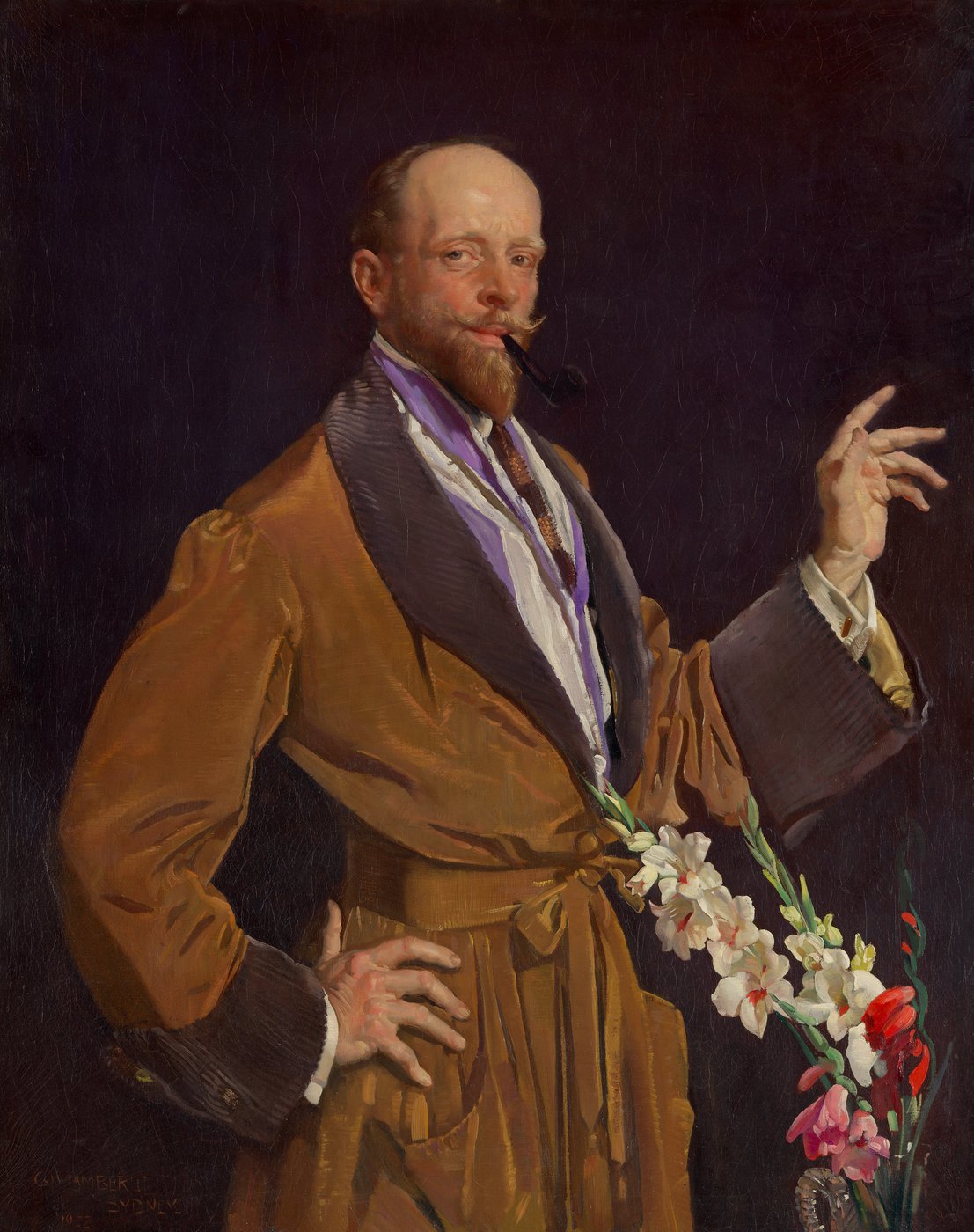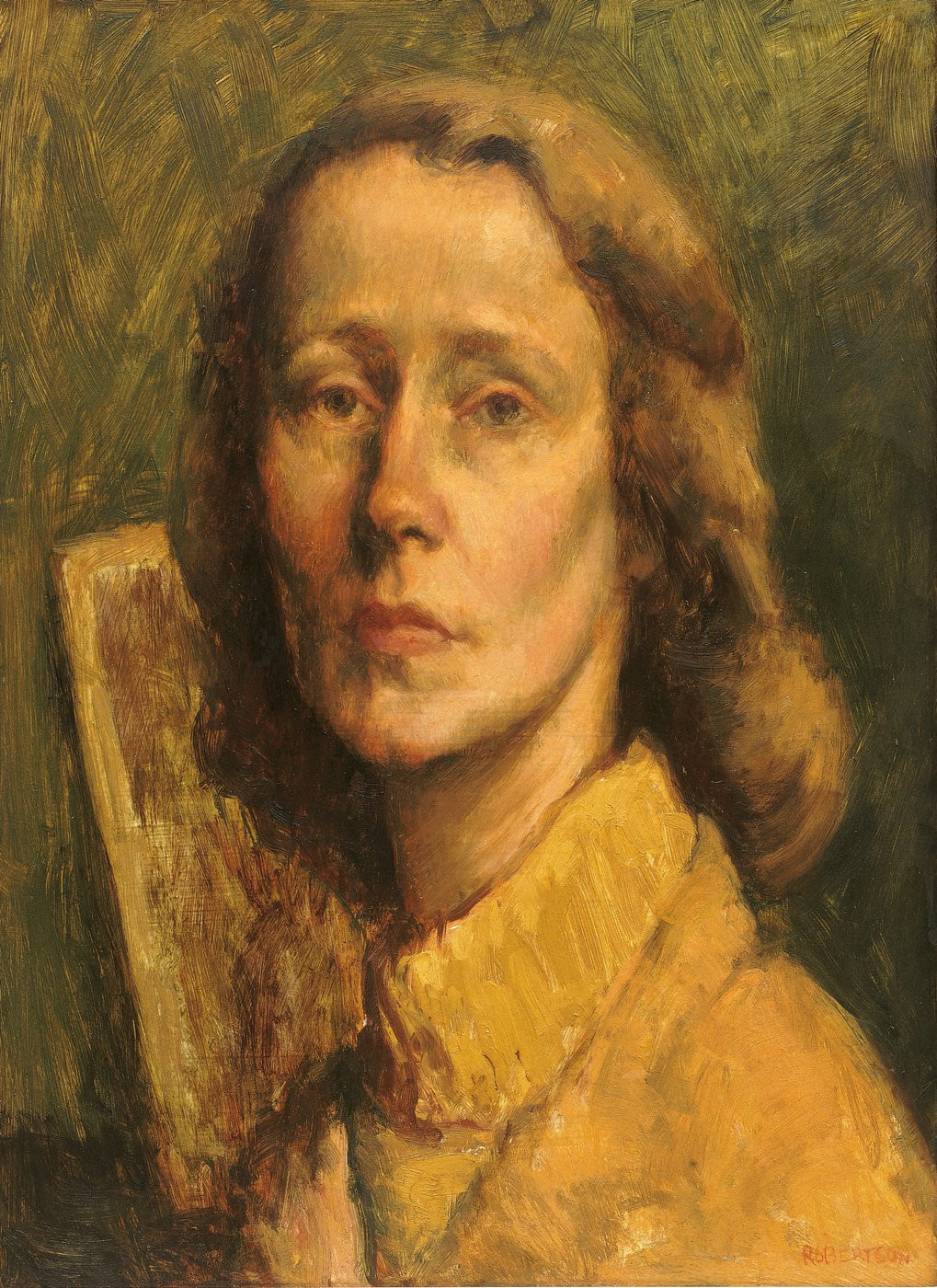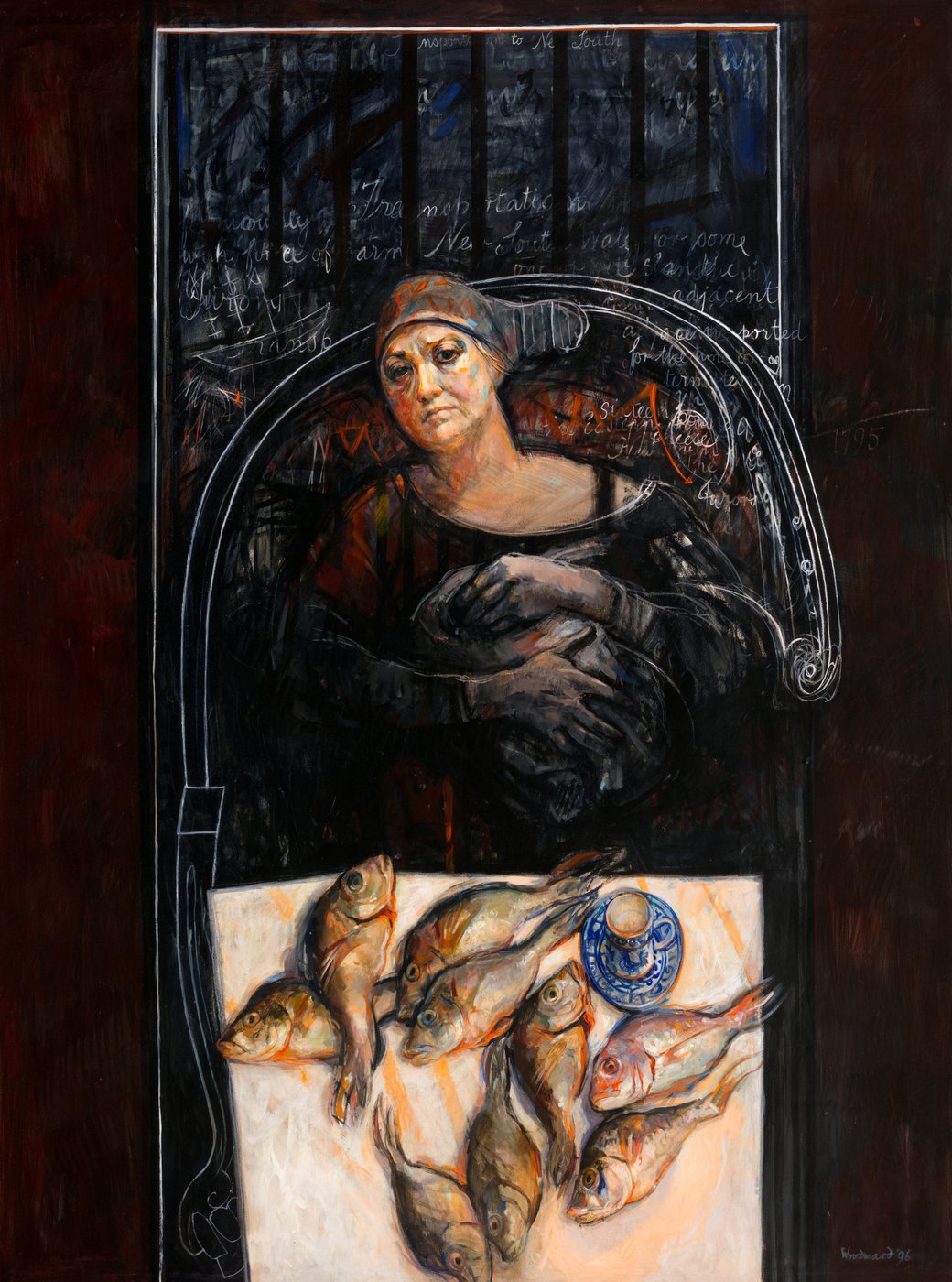Menu
Archie 100
A Century of the Archibald Prize
Wielding the brush
Wielding the brush
By far the most common subjects in the Archibald Prize are the artists themselves. Of more than 6000 portraits in the prize since 1921, over 900 are self-portraits. Merging the sitter and artist into one, self-portraits in the prize assert the painter’s status as meriting the term ‘distinguished’. In 1934, a then unknown artist named Henry Hanke was the first to win the Archibald Prize with a self-portrait. Since then, 13 self-portraits have won.
Self-portraits may also shed light on the artist’s psychological state, offering a form of autobiographical insight while constructing a public persona. Intimate and introspective, brash and flamboyant, puckish and comical; as British artist Julian Bell has noted, the self-portrait acts as a liminal zone between ‘seer and seen’. Self-portraiture also acts as an advertisement for technical prowess and self-promotion – a kind of calling card for future commissions – with the Archibald Prize itself the biggest catch.

George Lambert, Archibald Prize 1922
Self-portrait with gladioli
At 47 years old, George Lambert had achieved significant recognition and success in Britain and Australia when he painted this self-portrait. He had studied and worked in Paris and London and was an Associate of the Royal Academy in London, the only Australian painter to receive such an honour.
In this work, Lambert has deliberately chosen to represent himself as self-assured and peacockish, a contrivance that projects and reflects how he believed others viewed him. In reality, Lambert had just moved to Sydney and was exhausted by a relentless workload of commissions, lecturing and social commitments. Lambert commented in 1924:
Australia will of course expect great things and excitement when my self-portrait is exhibited in the RA … I just say it was my big effort and it cost me dearly in money and swat.
Controversially, both Lambert and John Longstaff removed their works within a fortnight of the opening of the 1922 exhibition. Both artists had been deemed ineligible for the award due to their residency. Despite having lived in Australia for over a year, London was still their postal address.
Lambert won the 1927 Archibald Prize with his portrayal of Annie Murdoch, mother of journalist and press baron Sir Keith Murdoch.

Henry Hanke, winner Archibald Prize 1934
Self-portrait
Within the prize’s history, there have been numerous controversies – as well as inspiring stories – that have captured viewers’ hearts and imaginations. Henry Hanke’s surprising win in 1934 was one. Hanke was 33 years of age and the first Sydney-born winner. A little-known artist, he struggled to survive and support his family during the Great Depression, with his only source of income a series of odd jobs and the government welfare program known as ‘sustenance relief’.
Hanke ground his own pigments, re-used a donated frame and, unable to afford a model, looked in the mirror. The portrait took just eight hours to complete. When interviewed about Hanke’s win, his former tutor JS Watkins responded:
When Hanke came to me eight or nine years ago, the one outstanding quality I recognised in him was his serious determination to make good – his intense power of application, and his willingness to tackle hard work.
Hanke is dressed in his down-on-his-luck workman’s clothes, yet his pluckiness and perseverance in winning the Archibald offered a story of hope for many Australians during the Depression. The portrait went on a celebratory national tour, with people flocking to locations around Australia to catch a glimpse of the work.

John Vickery, Archibald Prize 1933
Self-portrait
John Vickery’s heightened sense of colour and pattern is clearly visible in this spirited self-portrait, painted when he was 27 years old after a brief stint at the National Gallery School in Melbourne. Emigrating to America just two years later, Vickery is relatively unknown to the broader Australian public but recognised as an important artist of the international op art movement.
During the 1950s, Vickery painted alongside artists of the abstract expressionist movement in New York, such as Joan Mitchell and Willem de Kooning. The disciplined and analytical approach of op art, however, was more in line with his precise handling of colour and composition, honed over decades as a successful commercial illustrator.
While still in keeping with an academic tradition, the high-key palette and stippled, energetic brushwork of this self-portrait reflect Vickery’s burgeoning interest in cubism and the broken colour technique of the post-impressionists. The setting of the artist’s trenchcoat-clad figure against a crisp wintery landscape – his head framed by tufts of clouds – lends a slightly surreal quality to this avant-garde self-portrait. Few Archibald subjects have been depicted in outdoor settings.

Tempe Manning, Archibald Prize 1939
Self-portrait
Tempe Manning showed a talent and interest in art from a young age. She studied under Antonio Dattilo-Rubbo in Sydney, with a period in Paris just before World War I. In a departure from her French academic training, she began experimenting with pointillist colour theories and techniques. The work Manning produced at this time added to the first vital stage of modernist culture in Australia.
By the late 1920s, Manning returned to live in the family home in Bowral, New South Wales and concentrated on portrait commissions and teaching. Dattilo-Rubbo’s influence and the chromatic contrasts favoured by the early modernists, including contemporary Grace Cossington Smith, can be recognised in the rich palette of mauves and greens and loose, thick application of paint in this work. Manning renders an assured elegance and confidence in her pose and bold gaze, alluding both to George Lambert’s hand gestures and Henry Hanke’s stance in his 1934 winning portrait.
Manning believed in portraying a good ‘likeness’, writing in 1950:
By the word likeness I don’t mean to imply a purely superficial representation, but something that goes deeper and portrays the character of the sitter as shown in both face and hands. This is only something which concentrated study and careful handling can reveal.

Barbara Robertson, Archibald Prize 1950
Self-portrait
Barbara Robertson was aged 29 and living and working in Adelaide when she painted this portrait. She had just spent two years of intense study under William Dargie at the National Gallery School in Melbourne. Although never strictly aligned with a certain art group or movement, Robertson adopted particular teachings and approaches to develop her own unique style and practice; one that reflected her training, fascination with people, concern for social justice, and her strong desire to capture the person behind the face. In this work, we can see Robertson’s outstanding draughtsmanship, the complex interplay between light and shade through her subtle palette choice, and an expressive yet fine handling of paint.
In the early to mid 1950s, Robertson exhibited regularly with The Adelaide Group and won several awards, but familial and financial obligations took precedence over painting and exhibiting, and she took up teaching. Due to personal circumstances and her quiet and self-effacing nature, Robertson is not as widely known or celebrated as some of her female Australian contemporaries, such as Judy Cassab. It is this quiet profundity, determination and honesty that is sensitively captured in this work.

Margaret Woodward, Archibald Prize 1996
Self-portrait as Sarah Wisse, transported
The work of Margaret Woodward is multi-layered, utilising different mediums and visual modes, including text, symbols and drawing. Through the process of research and revelation, Woodward explores and reflects upon inner worlds, shared stories and the interconnectedness of life. Her subject matter is predominantly concerned with memory, place and the collective consciousness.
In this enigmatic self-portrait, Woodward has portrayed herself as her great-great-great-grandmother Sarah Wisse, who was transported as a convict from Britain to New South Wales in 1795 for stealing food and clothing. The work explores ancestry, time and the concept of judgement, with Woodward stating:
[it] alludes to the notion of the miraculous draught of fishes: by being required to put a net out on the other side of life’s boat, success was achieved together with a new beginning … The hints of text are like graffiti and are excerpts from Sarah’s judgement seen between the barred background. She carries a bundle in her arms representing the items she was suspected of having stolen.
A former National Art School student, Woodward taught art at secondary schools and colleges in both Sydney and Perth. Six of her eight Archibald works are self-portraits, and she was awarded the Wynne Prize for landscape painting in 1971.

William Robinson, winner Archibald Prize 1987
Equestrian self-portrait
One of two artists to have twice won the Archibald Prize with a self-portrait (the other being Brett Whiteley), William Robinson was a controversial and unexpected winner with this entry. His success brought the 51-year-old artist’s obscurity to an end, thrusting the ‘goat man’ into the national consciousness. Opinions were mixed, however, with then Art Gallery of New South Wales director Edmund Capon labelling the trees ‘bonsai vegetables’ and former Archibald winner Judy Cassab declaring ‘It’s beautifully painted and has a lot of humour’.
In this self-portrait, Robinson conjures traditional equestrian portraits and their association with aristocracy and privilege. He sits awkwardly astride a horse, without reins or bridle, looking uncertain. Robinson situates himself within his hallmark detailed and majestic landscape, with multiple and distorted perspectives and atmospheric use of colour. The work can be seen to parody both the pretentiousness that can arise in a highly sought-after annual art prize, and the self-important Archibald portraits from previous decades.
Robinson, whose influences include the works of Pierre Bonnard, Henri Matisse and Paul Cézanne, was a student at Brisbane’s Central Technical College in the 1950s. He drew inspiration from his cherished farm animals and the lush rainforest of Queensland’s Scenic Rim region, where he was living when awarded his first Archibald Prize with this work.

Peter Tyndall, Archibald Prize 1991/92
detail A Person Looks At A Work Of Art/someone looks at something …
In his works, Peter Tyndall investigates the act of looking and the relationship between the art object, the viewer and the gallery. He brings our attention to the idea that the process of looking at images is culturally constructed and conditioned by the context of their display, and how this influences the viewer’s perceptions and experience.
Employing humour, structural devices and schematic presentations – including his generic title arrangement and yellow trademark logo that references a hanging picture – Tyndall aims to disrupt our automatic responses and thoughts to encourage alternative ways of perceiving. Primarily a self-taught artist, Tyndall studied architecture at RMIT and the University of Melbourne, and has exhibited widely since the early 1970s.
Concerning this self-portrait, Tyndall wrote:
The drawing was made while looking into a circular mirror. This was then centred into a larger preparatory design, ringed by the appropriate-to-the-occasion quotation from [British writer] Charles Morgan … all set within the matrix of our interconnectedness … As with all of my artwork offerings, that which was/is to be beheld is the beholding projection of the beholder … in this portraiture context, a self-portrait, as also indicated in my standard title.
This – Tyndall’s only Archibald portrait – was included in the 1991/92 Archibald Prize.

Kate Beynon, Archibald Prize 2010
Self-portrait with guardian spirits
Kate Beynon’s work is a contemplation of her complex hybrid identity and transcultural life as a Chinese Malaysian/Welsh and Australian artist. Born in Hong Kong, Beynon lived in Singapore, Germany and England before emigrating to Australia. Now based in Melbourne, Beynon discovered early on that being creative and making art was a way to adjust and make connections to new places. Portraiture is integral to her practice as it provides an opportunity for Beynon to investigate and communicate her notions on personal history, hybridity, feminism and global culture.
In this self-portrait, which was highly commended by the Archibald judges, the artist sits in a half-lotus position surrounded by a large swirling gold-scaled Chinese dragon and two green lion-dogs – a reference to Beynon’s Staffy-cross, Tudo. Beynon blends personal and universal signs and symbols to help make sense of her identity and, in this work, the demands she feels in balancing an artistic and family life. This is evident in her choice of pose, the dragon (a positive symbol of strength and resistance), the two playful canine companions, and her mother’s jade pendant worn as a good luck charm. Beynon also draws on her interest in a range of traditional and contemporary pictorial sources, including animation, comic books, Chinese paintings and family connections.
Beynon is a finalist in the 2021 Archibald Prize with a portrayal of herself and her son.

Marc Etherington, Archibald Prize 2018
Me and Granny
In this self-portrait, Marc Etherington has depicted himself in a tender moment with Granny, his imagined pet dog. He has said about the portrait:
My wife Kate and I have been talking about getting a whippet for a while now. Our son Lars insists we name him Granny. We are keeping our eyes on the animal shelters and know that one day soon he will appear. We like to think he is out there looking for us as well.
A self-taught artist, Etherington started painting ‘weird little things’ to pass the time during a bleak winter in Edmonton, Canada 17 years ago. Etherington has since developed a distinctly personal style that references favourite television shows and movies from the 1980s and 1990s, childhood stories and daily family life. Through his use of colour and composition, Etherington’s artworks provide an insight into his inner thoughts, perspectives and imaginative worlds, which are at times surreal, weird and nostalgic. His love for playful details – here, the toy figurine and hose strewn on the grass, the lone yellow dandelion, and the seek-and-find lizard and spider hidden on the brick wall – reconnect the viewer to particular collective references or personal memories that feel familiar yet unexpected.

